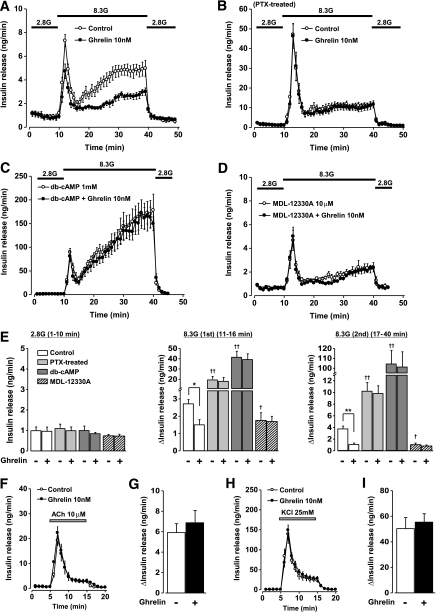FIG. 1.
Ghrelin attenuates glucose-induced insulin release in perfused rat pancreas in a cAMP pathway–dependent manner. Ghrelin was added 10 min prior to 8.3 mmol/L glucose challenge. A: Ghrelin (10 nmol/L) suppressed 8.3 mmol/L glucose (8.3G)-induced insulin release in perfused rat pancreas (n = 6). B: Ghrelin (10 nmol/L) did not alter glucose-induced insulin release from the perfused pancreas of PTX-treated rats (n = 6). C: In the presence of a 1 mmol/L dibutyryl-cAMP (db-cAMP), the glucose-induced insulin release was markedly enhanced and ghrelin failed to suppress it (n = 4–6). D: Following preincubation with an irreversible adenylate cyclase inhibitor MDL-12330A (10 μmol/L) for 30 min, the glucose-induced insulin release was attenuated and ghrelin (10 nmol/L) failed to suppress it (n = 3). E: Ghrelin (10 nmol/L) suppressed both the first and second phases of glucose-induced insulin release. In the pancreata from PTX-treated rats and those treated with a db-cAMP, both phases of glucose-induced insulin release were markedly enhanced and ghrelin failed to alter them. In the presence of MDL-12330A, both phases of the insulin release were suppressed, and ghrelin did not further suppress them. None of these treatments affected basal levels of insulin release at 2.8 mmol/L glucose (2.8G). *P < 0.05, **P < 0.01 vs. control; †P < 0.05, ††P < 0.01 vs. 8.3 mmol/L glucose alone (n = 3–6). Ghrelin (10 nmol/L) did not alter 10 μmol/L ACh-evoked (F and G) or 25 mmol/L KCl-evoked insulin release at 2.8 mmol/L glucose (H and I) (n = 4 for each condition).

